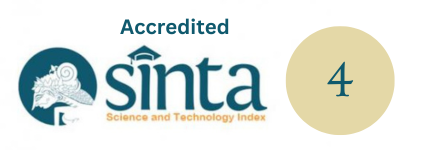Music composition Of Hayuning Rasa | Tabuh Kreasi Hayuning Rasa
DOI:
https://doi.org/10.59997/jurnalsenikarawitan.v2i1.388Keywords:
Gong Kebyar, Komposisi, KarawitanAbstract
Hayuning Rasa is a new creation of percussion that is still based on the existing tradition, then developed with a touch of creativity, both in terms of game technique, content, and parts of the song. By not eliminating musical elements, traditions, and adapting to the development of contemporary musical aesthetics, which are contained in the media, said Gamelan Gong Kebyar. This work has the theme of social life, which is inspired by life in a society that lives peacefully, happily and harmoniously which will be contained in the work of Tabuh Kreasi Hayuning Rasa. This cultivation method uses stages called Panca Sthiti Ngawi Sani. This stage will serve as a guide in creating a percussion creation of Hayuning Rasa, which consists of five stages: the inspiration stage (ngawirasa), the exploration stage (ngawacak), the conception stage (planning), the execution stage (ngawangun), the production stage (ngebah). The form of this work is the form and structure in the work of Tabuh Kreasi hayuning Rasa, which has various elements of musicality, accentuating the playing of instruments in each part, and the balance in this work is organized and arranged so that the relationship between parts can be realized and arranged systematically so that a work that has integrity. The structure consists of kawitan, crew and presses
Downloads
References
A.A.M, D. (2008). Estetika Sebuah Pengantar. Masyarakat Seni Pertunjukan Indonesia (MSPI).
Agus Gede Sukarta, I. K. M. (2021). Music Composition Bebarongan “Cepuk” | Tabuh Petegak Bebarongan “Cepuk.” GHURNITA: Jurnal Seni Karawitan, 01(01), 29–36. https://doi.org/10.25124/ghurnita.v1i1.150
Aryasa, dkk. (1984). pengetahuan karawitan Bali. Departemen Pendidikan Dan Kebudayaan Direktorat Jendral Kebudayaan Proyek Pengembangan Kesenian Bali.
Bandem, I. M. (1986). Prakempa Sebuah Lontar Gambelan Bali. ASTI Denpasar.
Bandem, I. M. (2013). Gamelan Bali di atas Panggung Sejarah. Badan Penerbit STIKOM Bali.
Dibia, I. W. (2012). Taksu Dalam Seni dan Kehidupan Bali (Cetakan II). Bali Mangsi Foundation.
Dibia, I. W. (2017). Kotekan Dalam Musik Dan Kehidupan Bali. Bali Mangsi Foundation dan ISI Denpasar.
Dibia, I. W. (2020). Panca Sthiti Ngawi Sani Metodologi Penciptaan Seni. Pusat Penerbitan LPPMPP Institut Seni Indonesia Denpasar.
Hastanto, S. (n.d.). Ngeng Dan Reng; Persandingan Sistem Pelarasan Gamelan Ageng Jawa Dan Kebyar Bali. In 2012. ISI Press.
Rembang, I. N. (1985). Hasil Pendokumentasian Notasi Gending-Gending Lelambatan klasik pegongan daerah bali. Departemen Pendidikan dan Kebudayaan.
Santosa, H. S. (2016). Gamelan Sistem Sepuluh Nada dalam Satu Gembyang untuk Olah Kreativitas Karawitan Bali. Pantun, 1(2), 85–96. https://jurnal.isbi.ac.id/index.php/pantun/article/view/747
Sugiartha, I. G. A. (2012). Kreativitas Musik Bali Garapan Baru Perspektif Cultural Studies. Institut Seni Indonesia Denpasar.
Sukerta, P. M. (1998). Ensiklopedi Karawitan Bali. Masyarakat Seni Pertunjukan Indonesia (MPSI).
Supriyadnyana, P. G. Wirya, Mustika, P. G., & Muryana, K. (2020). Tabuh Kreasi Pepanggulan AMANDE. Kalangwan: Jurnal Seni Pertunjukan, 6(1), 16–25. https://jurnal.isi-dps.ac.id/index.php/kalangwan/article/view/1115
Yasa, I. G. J. M. Y. N. P. T. A. (2021). Tabuh Lelambatan Klakat Sudhamala: A New Creative Musical Composition | Tabuh Lelambatan Klakat Sudhamala: Sebuah Komposisi Karawitan Kreasi Baru. GHURNITA: Jurnal Seni Karawitan, 01(01), 37–46. https://jurnal2.isi-dps.ac.id/index.php/ghurnita/article/view/191








